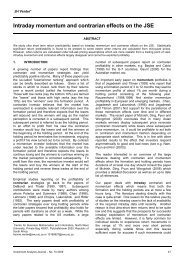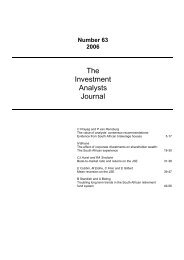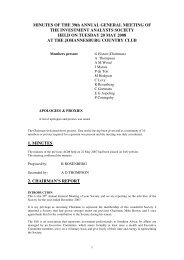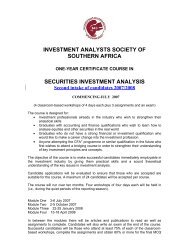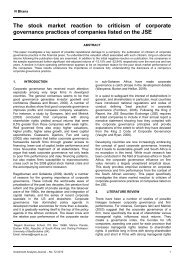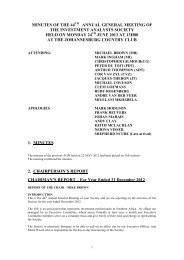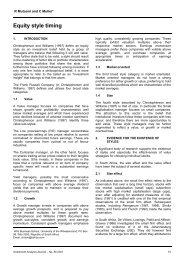Pricing of single stock futures and dividend risk - Investment ...
Pricing of single stock futures and dividend risk - Investment ...
Pricing of single stock futures and dividend risk - Investment ...
Create successful ePaper yourself
Turn your PDF publications into a flip-book with our unique Google optimized e-Paper software.
<strong>Pricing</strong> <strong>of</strong> <strong>single</strong> <strong>stock</strong> <strong>futures</strong> <strong>and</strong> <strong>dividend</strong> <strong>risk</strong><br />
Assume that r = 0,10; <strong>and</strong> (T d) = 20/365. The<br />
change is announced at time t < d. At that time the<br />
price must therefore change from<br />
SSF(t) = S(t)[1 + r(T – t)] – D[1 + r(T – d)]<br />
to<br />
SSF(t) = S(t)[1 + r(T – t)] – 0,9D[1 + r(T – d)].<br />
The (almost instantaneous) change in theoretical value<br />
<strong>of</strong> the SSF price is:<br />
0,1D[1 + 0,1 (20/365)] = 0,101D. This is a 10,1%<br />
change in the <strong>futures</strong> price <strong>and</strong> re-pricing will have to<br />
take place.<br />
4. DEALING WITH DIVIDEND RISK –<br />
DIVIDEND FUTURES<br />
Dividends in general can themselves be traded in<br />
various ways, for example with products such as<br />
contracts for difference <strong>and</strong> <strong>dividend</strong> swaps.<br />
Specifically in the case <strong>of</strong> SSFs there has been<br />
considerable dem<strong>and</strong> for tools to manage <strong>dividend</strong><br />
uncertainty. One tool is obviously to create products<br />
that can be used to hedge <strong>dividend</strong> <strong>risk</strong>. The <strong>dividend</strong><br />
<strong>futures</strong> contract is such a product.<br />
The <strong>dividend</strong> future (DIVF) is a derivative contract that<br />
can be used to hedge against the <strong>dividend</strong> <strong>risk</strong> that<br />
accompanies trade in SSFs. The DIVF contract is<br />
booked in conjunction with an SSF. Basically the<br />
combination becomes an SSF on a <strong>stock</strong> without<br />
<strong>dividend</strong>s where the actual <strong>dividend</strong> amount is then<br />
exchanged. The investor is compensated in this way<br />
for the drop in share price. The price <strong>of</strong> the SSF on a<br />
non-<strong>dividend</strong> paying <strong>stock</strong> is <strong>of</strong> course simply SSF(t) =<br />
S(t)[1 + r(T – t)]. Dividends do not have to be<br />
predicted, they are simply exchanged <strong>and</strong> <strong>dividend</strong> <strong>risk</strong><br />
is eliminated.<br />
There is no doubt as to the importance <strong>of</strong> the DIVF<br />
market as a tool to manage <strong>dividend</strong> <strong>risk</strong>. One<br />
“disadvantage” for investors in SSFs may be that they<br />
are in effect obliged to enter into an additional contract<br />
to hedge <strong>dividend</strong> uncertainty. Another potential<br />
problem is that the <strong>dividend</strong> <strong>futures</strong> market is not<br />
always very liquid. Eurostoxx 50 <strong>dividend</strong> <strong>futures</strong> saw<br />
a collapse in May 2010 (Cameron <strong>and</strong> Wood, 2010).<br />
An illiquid DIVF market means investors may have<br />
difficulty in using <strong>dividend</strong> <strong>futures</strong> as hedging<br />
instrument.<br />
Another way <strong>of</strong> addressing <strong>dividend</strong> <strong>risk</strong> in SSFs would<br />
be to improve the modelling <strong>of</strong> the discrete <strong>dividend</strong><br />
component in the pricing <strong>of</strong> the SSF.<br />
5. DIVIDEND MODELLING: A NEW MODEL<br />
FOR ESTABLISHING THE FAIR PRICE OF<br />
AN SSF<br />
The modelling <strong>of</strong> discrete cash <strong>dividend</strong>s is one <strong>of</strong> the<br />
big challenges in pricing equity derivative products: the<br />
modelling must address the need for compensation<br />
due to the drop in the underlying share price when the<br />
<strong>dividend</strong> is paid. In the case <strong>of</strong> the pricing <strong>of</strong> options on<br />
shares with discrete <strong>dividend</strong>s, a variety <strong>of</strong> different<br />
pricing models have been developed. See Musiela <strong>and</strong><br />
Rutkowski, 1997; Bos <strong>and</strong> V<strong>and</strong>ermark, 2002; Bos,<br />
Gairat <strong>and</strong> Shepeleva, 2003; Frischling, 2002; Haug et<br />
al., 2003; Vellekoop <strong>and</strong> Nieuwenhuis, 2006.<br />
In SSF pricing however, all available evidence shows<br />
that discrete <strong>dividend</strong>s have always been dealt with<br />
(as shown in Section 2.2) by introducing the “reduced”<br />
capital process [S(t) – e −r(d− t) D] for times t < d. That is,<br />
the present value <strong>of</strong> the forecast <strong>dividend</strong> is deducted<br />
from the share price S at t < d so that compensation<br />
takes place before the <strong>dividend</strong> is paid.<br />
We suggest that the SSF pricing formula can be<br />
modified by developing a new model for discrete<br />
<strong>dividend</strong>s. The new model introduces an “augmented”<br />
capital process that uses the future value <strong>of</strong> the actual<br />
declared <strong>dividend</strong> amount for compensation at times<br />
t > d.<br />
As a first step we distinguish between assumed<br />
<strong>dividend</strong> D <strong>and</strong> actual declared <strong>dividend</strong> D dec . We then<br />
propose a pricing model which is based on the actual<br />
<strong>dividend</strong> date d <strong>and</strong> amount D dec . Let S denote the<br />
usual <strong>stock</strong> price process <strong>and</strong> let S* be the process<br />
defined by<br />
<br />
<br />
r(td)<br />
S t for 0 t d<br />
<br />
S * t<br />
S t Ddece<br />
<br />
for t d.<br />
<br />
… (6)<br />
The <strong>dividend</strong> component in S*at t > d contains the<br />
future value <strong>of</strong> the actual declared <strong>dividend</strong> <strong>and</strong> is<br />
added to S(t) to compensate for the drop in share price<br />
at t = d. Process S* can be seen as an equivalent<br />
“augmented” or “<strong>dividend</strong>-compensated” process for S.<br />
The continuous-time <strong>futures</strong> price formula for S*(t) is<br />
then: F(t, T, S*) = S*(t) e r (T t) . Using Equation (6) we<br />
get the new <strong>futures</strong> pricing formula F* in terms <strong>of</strong> S:<br />
<br />
<br />
<br />
r(Tt)<br />
<br />
S t e for 0 t d<br />
r(Tt) r(Td)<br />
F * t, S<br />
S t e Ddece<br />
<br />
fort d.<br />
<br />
… (7)<br />
40 <strong>Investment</strong> Analysts Journal – No. 73 2011




